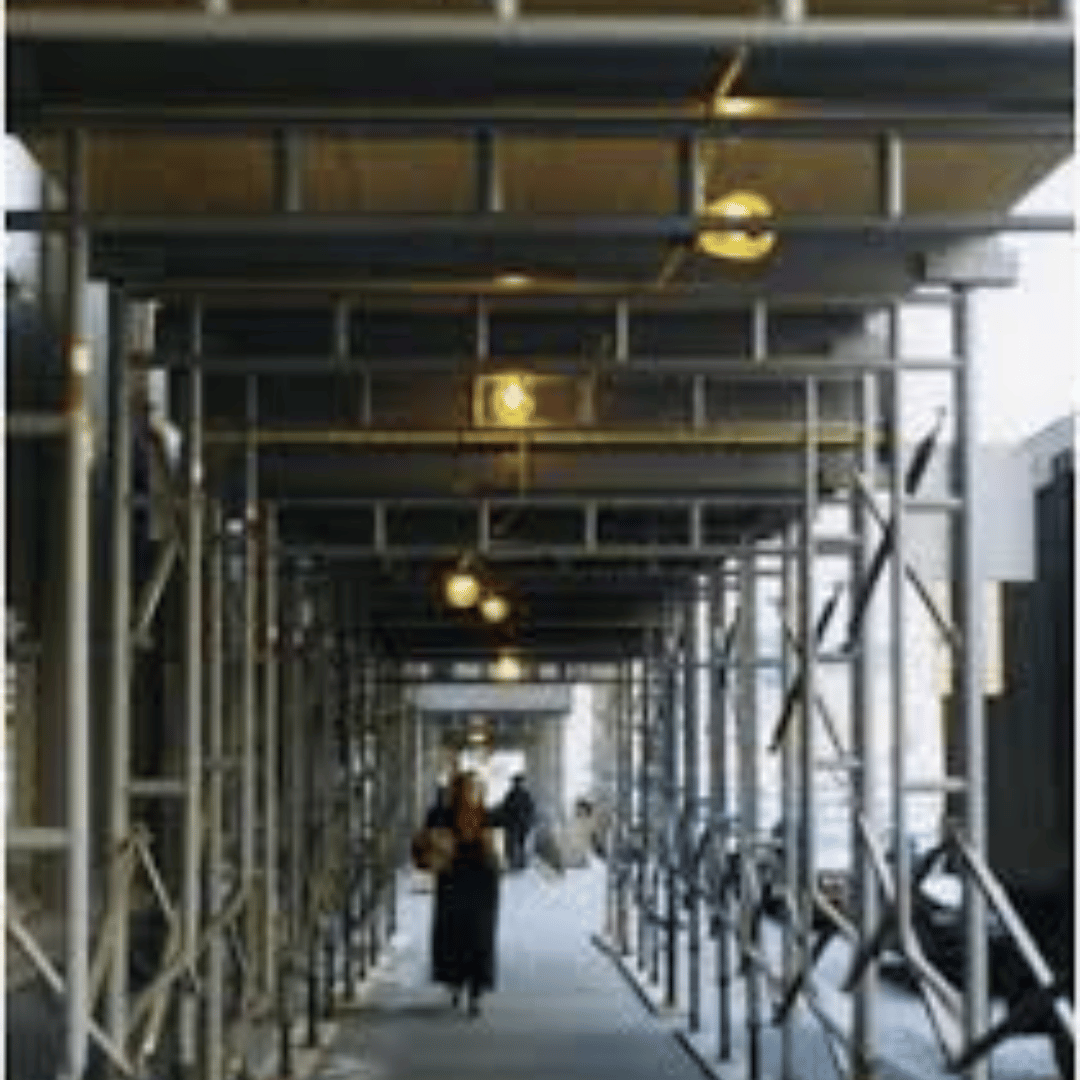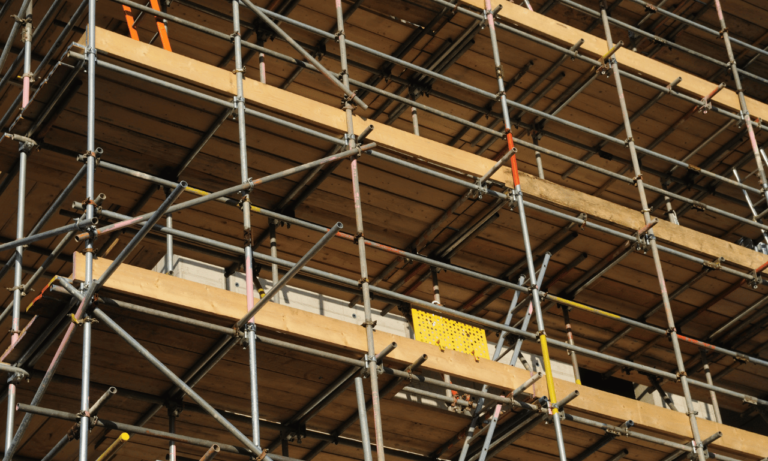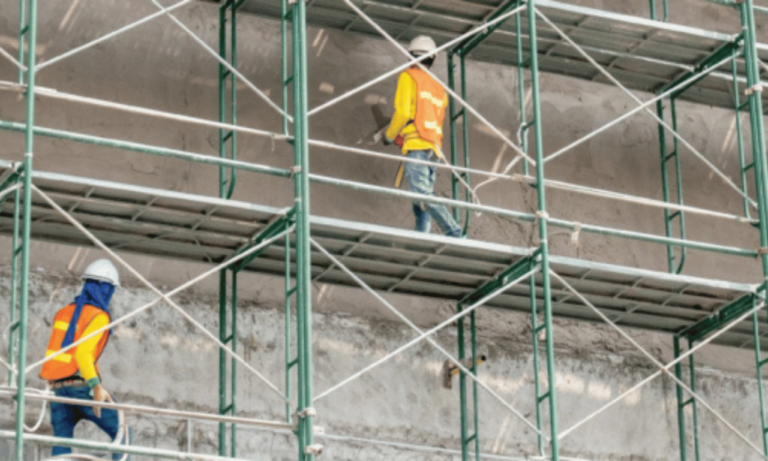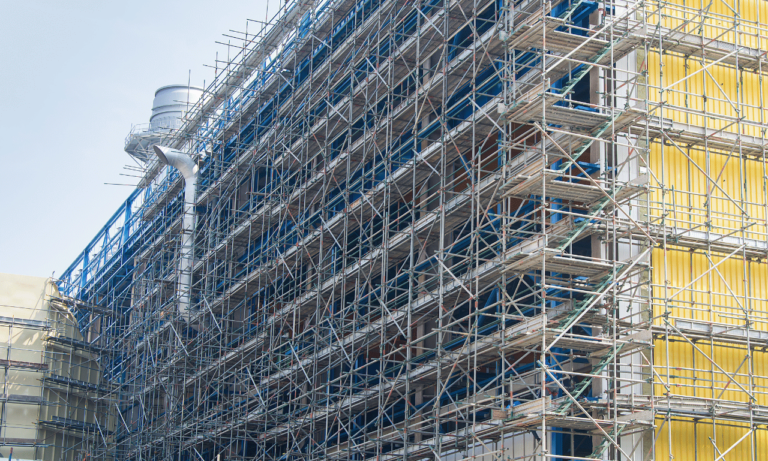Phone:
(+65)8319-0742
Pedestrian walkway scaffolding plays a critical role in ensuring the safety of workers and pedestrians on a construction site. Proper setup and adherence to safety guidelines are essential to minimize the risk of accidents and injuries. By incorporating walkway safety equipment and implementing construction site safety measures, construction companies can create a safer environment for everyone involved.
Key Takeaways:
- Pedestrian walkway scaffolding is crucial for construction site safety.
- Follow general scaffolding requirements and best practices to ensure stability and load support.
- Include safety features such as guardrails, debris screens, and secure platforms.
- Implement perimeter and fall debris protection measures to prevent accidents.
- Invest in walkway safety equipment to enhance pedestrian safety.
General Requirements and Best Practices for Scaffolding
Scaffolding plays a critical role in construction site safety, providing a temporary structure that enables workers to perform tasks at elevated heights. To ensure the highest level of safety, adherence to general requirements and best practices is essential. By following these guidelines, construction companies can minimize the risk of accidents, injuries, and other potential hazards. The crossing point of cross braces in scaffolding systems is crucial for ensuring stability and safety. Proper positioning of these crossing points between specified heights relative to the work platform is necessary to comply with safety regulations.
Stable Base
The foundation of any scaffolding system is its base. It must be stable and capable of supporting the weight and load requirements. For optimal stability, scaffolding should be erected on solid ground, preferably concrete or compacted soil. Uneven terrain should be leveled before installation. The use of foundation plates or jacks can also enhance stability, especially on soft or uneven surfaces.
Trained Workers
The assembly, disassembly, and operation of scaffold systems should only be performed by trained and competent workers. These individuals should have a thorough understanding of the scaffold’s design, components, and safety procedures. By employing qualified personnel, the risk of improper installation or usage is greatly reduced, ensuring a safer work environment for everyone involved.
Proper Load Support
It is imperative to determine the load-bearing capacity of scaffolding systems and ensure they are not overloaded. Load calculations should consider the combined weight of workers, equipment, and materials. Adhering to these load limits prevents structural failures, collapses, and potential injuries. Scaffold components should be inspected regularly to identify any signs of deformation, corrosion, or damage that may compromise their load-bearing capabilities.
Guardrails, Debris Screens, and Secure Planking and Platforms
Scaffold systems must be equipped with guardrails on all open sides and ends to prevent falls. Debris screens are also crucial, as they provide protection against falling objects and minimize the risk of injury to workers and pedestrians below. Additionally, secure planking and platforms should be provided to ensure stability and support for workers on elevated levels.
Easy Access and Overhand Bricklaying Protection
Access to scaffolding should be convenient, efficient, and properly designed. Ladders, stair towers, or ramp systems should be utilized to provide safe entry and exit points. Furthermore, overhand bricklaying protection, such as cantilever scaffolding or hop-up brackets, should be implemented to safeguard workers during masonry work.
Compliance, Maintenance, and Inspection
Scaffolding systems must comply with applicable regulations, standards, and industry guidelines, such as those set forth by OSHA. Regular maintenance and inspection are crucial to identify and address any potential issues promptly. Inspections should be conducted before initial use, after any modifications, and at regular intervals throughout the project. Documentation of inspections, repairs, and maintenance activities should be maintained for future reference.
By adhering to these general requirements and best practices, construction companies can establish a solid foundation for safe scaffold systems. Prioritizing construction site safety not only protects workers and pedestrians but also contributes to a productive and successful construction project.
Perimeter and Fall Debris Protection
Ensuring the safety of pedestrians and workers on a construction site is of utmost importance, and one key aspect of achieving this is perimeter and fall debris protection. By implementing the right walkway safety equipment and measures, construction companies can prevent injuries and create a safer environment for everyone involved.
Debris netting is a critical component of perimeter protection. It acts as a safety barrier, catching falling objects and preventing them from causing harm to pedestrians or workers below. The netting should be securely installed, covering all areas where objects may potentially fall.
Additionally, the use of protective canopies is essential for providing overhead protection to pedestrians. These canopies shield individuals from falling debris, dust, and other hazards, creating a safe passage along the walkway. Proper installation and regular inspection of canopies ensure their effectiveness in safeguarding pedestrians.
Another vital component of perimeter and fall debris protection is the use of debris chutes. These chutes provide a convenient and safe way to dispose of construction waste, preventing potential hazards caused by scattered debris. By directing waste to designated collection points, debris chutes help maintain cleanliness and minimize the risk of accidents.
By adhering to these recommended measures, construction companies can significantly reduce the potential for injuries and accidents related to falling objects and debris. Implementing walkway safety equipment, such as debris netting, protective canopies, and debris chutes, creates a secure and controlled environment for all individuals on the construction site.
Perimeter and Fall Debris Protection: Summary of Safety Measures
| Safety Measure | Description |
|---|---|
| Debris Netting | Captures falling objects, preventing injuries |
| Protective Canopies | Provides overhead protection from debris and dust |
| Debris Chutes | Enables safe disposal of construction waste |
By incorporating these safety measures into the construction site, companies can prioritize the well-being of pedestrians and workers, reducing the chances of accidents and creating a secure environment for all.
Pedestrian Safety Features
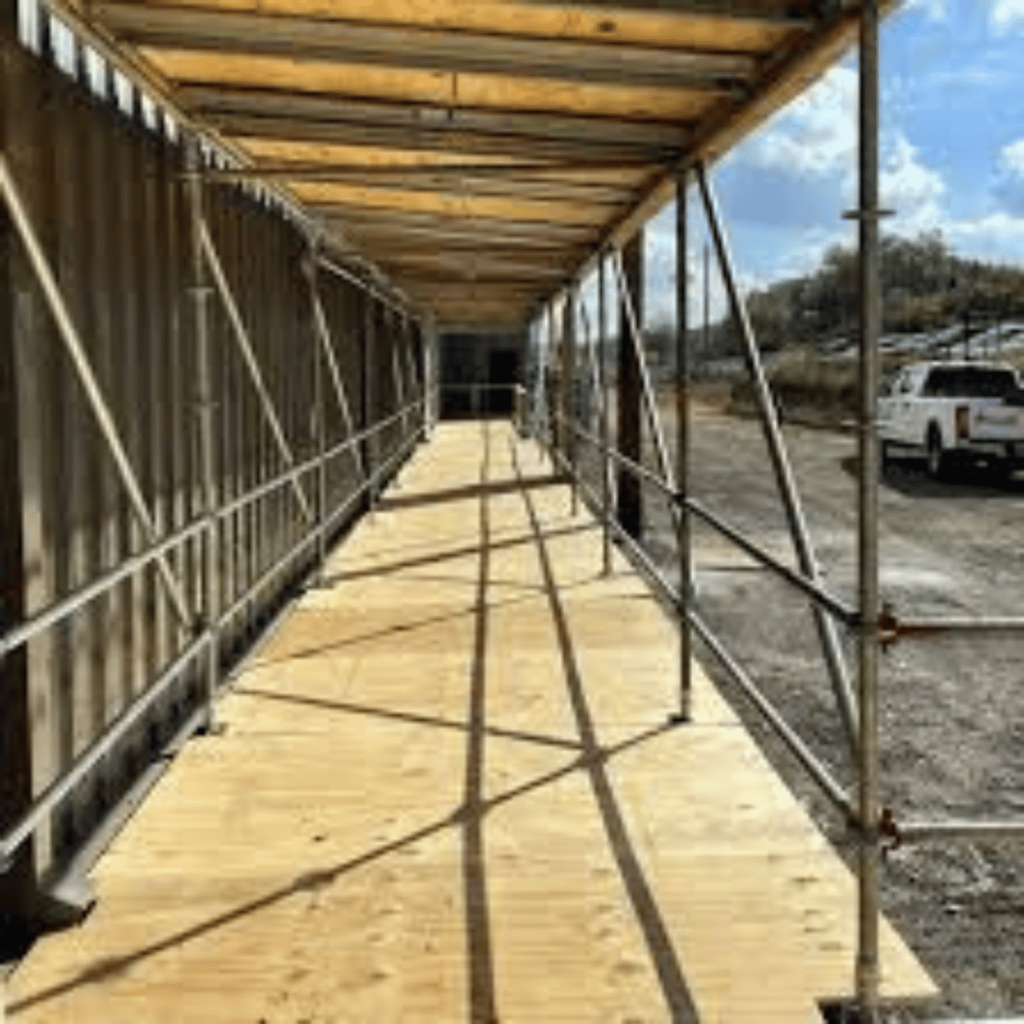
When it comes to pedestrian walkway scaffolding, safety is of utmost importance. By incorporating various features into the scaffolding design, construction sites can ensure the well-being of pedestrians and minimize potential hazards. Let’s take a look at some key safety features:
Elevated Walkway System
One important safety feature is the elevated walkway system, which provides a dedicated path for pedestrians to move safely through the construction site. This system is designed to keep pedestrians away from the potential dangers of active construction areas, ensuring their safety and allowing work to proceed smoothly.
Debris Netting
An essential safety measure is the use of debris netting. This protective barrier is installed along the scaffolding to prevent falling objects and debris from reaching the ground or potentially injuring pedestrians. Debris netting not only safeguards pedestrians but also helps maintain a clean and organized construction site.
Mobile Scaffold Platforms
Mobile scaffold platforms play a vital role in enhancing pedestrian safety on construction sites. These versatile platforms provide a stable and elevated surface for workers to perform their tasks at various heights. By ensuring a secure and accessible work area, mobile scaffold platforms eliminate the risk of accidents caused by unstable or inadequate platforms.
Overhead Protection
Another crucial safety feature is the installation of pedestrian canopies. These canopies provide overhead protection for pedestrians, shielding them from falling debris, dust, and other potential hazards. By creating a safe and protected area for pedestrians, construction sites can mitigate the risk of injuries and ensure a secure environment.
Waste Disposal Chutes
Proper waste management is essential for maintaining safety on construction sites. Waste disposal chutes allow workers to dispose of construction debris safely and efficiently, reducing the chances of tripping hazards or falling objects. By implementing waste disposal chutes within the scaffolding structure, construction sites can keep pedestrian walkways clear of debris and minimize potential risks.
Shrink-Wrap
For projects that require additional protection, shrink-wrap can be applied to the scaffolding structure. Shrink-wrapping offers enhanced security, safeguarding the building from strong winds, weather conditions, and environmental factors. This protective layer not only ensures the stability of the structure but also provides an added safety measure for pedestrians passing nearby.
By incorporating these pedestrian safety features into the walkway scaffolding design, construction sites can create a secure environment for both workers and pedestrians. Implementing measures such as elevated walkway systems, debris netting, mobile scaffold platforms, overhead protection, waste disposal chutes, and shrink-wrap significantly reduces the risk of accidents and injuries. Prioritizing pedestrian safety is essential to a successful and safe construction project.
Benefits of Walkway Safety Equipment
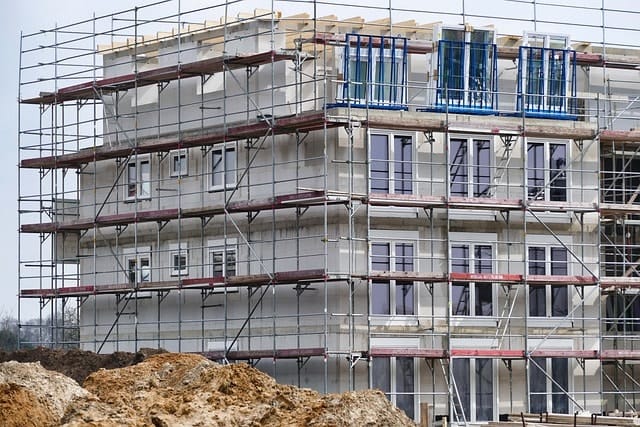
Walkway safety equipment plays a crucial role in ensuring the safety of workers and pedestrians on construction sites. By investing in high-quality walkway safety equipment, construction companies can significantly reduce the risk of accidents and create a safer environment for everyone involved.
Prevention of Injuries
One of the key benefits of walkway safety equipment is its ability to prevent injuries. Debris netting, for example, acts as a protective barrier, preventing objects from falling and potentially causing harm to workers or pedestrians below. Similarly, pedestrian canopies provide overhead coverage, shielding pedestrians from construction debris and dust, reducing the risk of respiratory issues.
Risk Mitigation
Walkway safety equipment helps to minimize the risk of falling objects on construction sites. Scaffold systems equipped with properly installed debris netting act as a safeguard, catching any objects that may accidentally slip or be knocked off elevated platforms. This measure not only protects workers and pedestrians but also prevents damage to property or nearby structures.
Dust Protection
Construction sites often produce a significant amount of dust, which can be hazardous to both workers and pedestrians. Walkway safety equipment, such as pedestrian canopies, acts as a shield, providing protection against airborne particles. This feature promotes a healthier working environment and reduces the risk of respiratory issues associated with prolonged exposure to dust.
Weather Resilience
Walkway safety equipment, including shrink-wrap, offers protection against adverse weather conditions. By securing the construction site with shrink-wrap, construction companies can safeguard the structure from strong winds and other elements. This added level of weather resilience helps to maintain a safe working environment and prevents potential accidents or damage caused by unfavorable weather conditions.
| Benefits | Walkway Safety Equipment |
|---|---|
| Prevention of Injuries | Debris netting, pedestrian canopies |
| Risk Mitigation | Debris netting |
| Dust Protection | Pedestrian canopies |
| Weather Resilience | Shrink-wrap |
By leveraging walkway safety equipment, construction companies can ensure the well-being of their workers and pedestrians, while also mitigating potential risks and complying with safety regulations. Investing in scaffold systems, pedestrian access solutions, and walkway safety equipment is a proactive step towards creating a safer construction site for all.
Conclusion
Safety is of utmost importance in any construction site, particularly when it comes to pedestrian walkway scaffolding. By adhering to general scaffolding requirements and best practices, implementing effective perimeter and fall debris protection measures, and utilizing walkway safety equipment, construction companies can establish a safer environment for both workers and pedestrians. These precautions significantly reduce the risks of accidents and injuries, ensuring the smooth and successful execution of any construction project.
Industrial scaffolding solutions play a vital role in ensuring construction site safety. Rigorous adherence to safety standards and practices, such as providing a stable base, utilizing trained workers, and ensuring proper load support, is essential. Additionally, implementing safety features such as guardrails, debris screens, secure planking, and platforms further enhances the protection of workers and pedestrians on construction sites.
Construction companies must also address potential hazards associated with falling debris and dust. Installing debris netting, protective canopies, and waste disposal chutes creates barriers that prevent accidents and injuries. Similarly, fortifying the construction site against strong winds using shrink-wrap offers added security. By incorporating such walkway safety equipment, construction companies demonstrate their commitment to creating a secure working environment.
FAQ
What is pedestrian walkway scaffolding?
Pedestrian walkway scaffolding is a temporary elevated structure used to provide safe passage for pedestrians on a construction site. It typically consists of platforms, guardrails, and other safety features to prevent falls and protect both workers and pedestrians.
Why is pedestrian walkway scaffolding important for construction site safety?
Pedestrian walkway scaffolding is crucial for ensuring the safety of workers and pedestrians on a construction site. It provides a designated path for pedestrians, preventing them from coming into contact with potential hazards or interfering with ongoing construction activities.
What are the general requirements and best practices for scaffolding?
General requirements and best practices for scaffolding include having a stable base, utilizing trained workers, implementing proper load support, and ensuring the presence of guardrails, debris screens, secure planking, and platforms. Easy access and overhand bricklaying protection should also be considered.
How can perimeter and fall debris protection be achieved?
Perimeter and fall debris protection can be achieved by using debris netting to catch falling objects, implementing protective canopies to shield pedestrians from debris and dust, and utilizing debris chutes for safe disposal of construction waste.
What pedestrian safety features can be incorporated into walkway scaffolding?
Pedestrian walkway scaffolding can incorporate safety features such as guardrails, secure platforms, elevated walkway systems, and mobile scaffold platforms to ensure the safety of pedestrians. These features help prevent falls and provide a secure passage for pedestrians on the construction site.
What are the benefits of walkway safety equipment?
Walkway safety equipment, such as debris netting, pedestrian canopies, waste disposal chutes, and shrink-wrap, offers several benefits for construction sites. These safety measures help prevent injuries to both workers and pedestrians, minimize the risk of falling objects, protect against dust exposure, and secure the construction site from strong winds.

